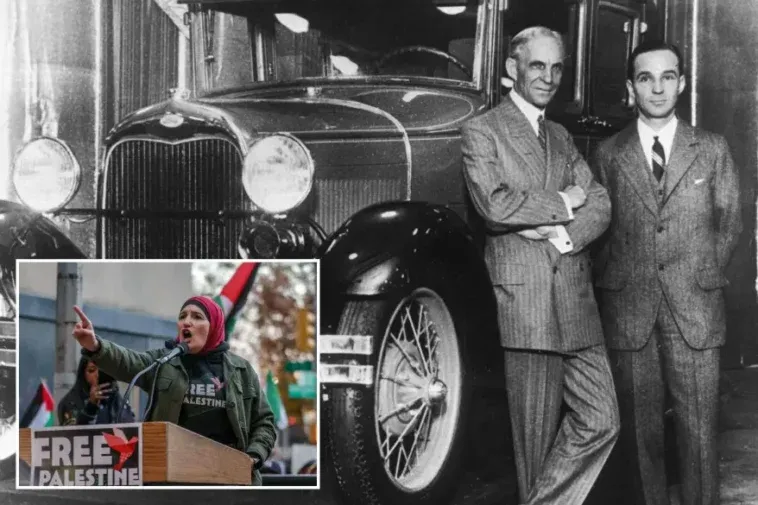(New York Post) It’s November 2023, and, following the Oct. 7 attacks by Hamas terrorists that killed some 1,400 Israelis and at least 31 Americans, thousands of demonstrators march through New York City, calling for the destruction of the Jewish state.
Chants of “from the river to the sea, Palestine will be free” echo through the streets, along with: “There is only one solution: intifada revolution.”
Among the crowd is the infamous Palestinian American activist Linda Sarsour, who warns through a megaphone that a cabal of wily Jews has conspired to place “their little posters” (of kidnapped Israeli civilians) across the city, seeking to entice people to rip them down.
While many onlookers might look like “ordinary people,” she says, the Jews have “their little people all around the city,” surveilling others.
Sarsour is there to deliver such rhetoric in part because she’s been paid to be there. Her nonprofit, MPower Change, has received $300,000 in grant funding from the Ford Foundation “to build grassroots Muslim power.”
It’s May 2023, and protesters have stormed the Capitol building in Washington, DC, to demand that lawmakers not accept spending cuts during negotiations to lift the debt ceiling. Many are so disruptive that the police arrest them and drag them out.
These are activists of the Center for Popular Democracy, an extreme left-wing organization that has collected $35.2 million from the Ford Foundation since 2012.
Four months later they will be imitated by 150 youth activists from “climate revolution” group the Sunrise Movement, 18 of whom will be arrested after occupying the speaker of the House’s office.
The Sunrise Movement also receives Ford Foundation money — $650,000 for “training and organizing.”
No cause off-limits
It’s April 2023, and, a world away, the China Development Research Foundation (CDRF), a think tank set up and directed by the Chinese state, is hosting a conference in Beijing to discuss how to “promote the formation of an internationally accepted ESG system with Chinese characteristics,” including through China’s globe-spanning influence and infrastructure plan, the Belt and Road Initiative.
But this effort by America’s top geopolitical adversary isn’t too far afield for the Ford Foundation to fund; it has given CDRF $600,000 to help realize its ambitions.
These examples from just the past year — collected via a semi-random tour of the Ford Foundation’s vast Grants Database — represent a tiny fraction of the nearly $1 billion that the foundation gives away yearly on average.
Almost a century old and sitting on a mountainous $16.4 billion endowment in 2022, the foundation is a “philanthropic” giant — one of the five largest in the US
If it were a for-profit firm, its market capitalization would rank it among the Fortune 500.
Instead, “guided by a vision of social justice,” as its mission statement puts it, the Ford Foundation’s enormous flood of untaxed money flows annually to an immense ecosystem of overwhelmingly left-wing — and often outright revolutionary — causes.
Yet its activities remain largely below the public’s radar, the extent of its malign history mostly unknown. This should change.
America today faces a multitude of escalating sociopolitical crises that are rapidly tearing apart the body politic: a rapacious strain of tribal identity politics; spreading legal, cultural, and moral chaos; lawlessness in the streets; and the entrenchment of an oligarchic managerial elite, increasingly willing to cast aside any remaining shred of democratic or national sovereignty in its pursuit of top-down global “progress.”
Behind every one of these fractures, one finds the ongoing work of the Ford Foundation.
It wasn’t originally intended to be a beacon for leftist revolutionaries. Industrialist Henry Ford founded it in 1936 as a tax dodge.
Tax dodge to unaccountable
Crippling inheritance taxes imposed by Franklin Delano Roosevelt’s antitrust Revenue Act threatened to end family control of the Ford Motor Company — hence, a philanthropic awakening.
When Ford died in 1947, 90% of company holdings were bequeathed as nonvoting shares to the foundation, protecting the family from having to sell stock to raise cash.
Then, in a successful maneuver to shield from government scrutiny what was now the world’s largest private foundation, successor Henry Ford II transitioned it into an independent entity that sought to portray itself as an arms-length instrument for America’s Cold War liberal establishment, at home and abroad.
By the 1960s, however, following America’s intelligentsia, the Ford Foundation’s managers came to believe that human welfare would be best served not by building and maintaining lasting institutions and norms but by tearing them down.
As Heather Mac Donald chronicled in City Journal almost three decades ago, the foundation’s trustees, energized by John F. Kennedy’s 1960 election, started “clamoring for a more radical vision,” and, according to a former employee, demanded “action-oriented rather than research-oriented” initiatives to “test the outer edges of advocacy.”







